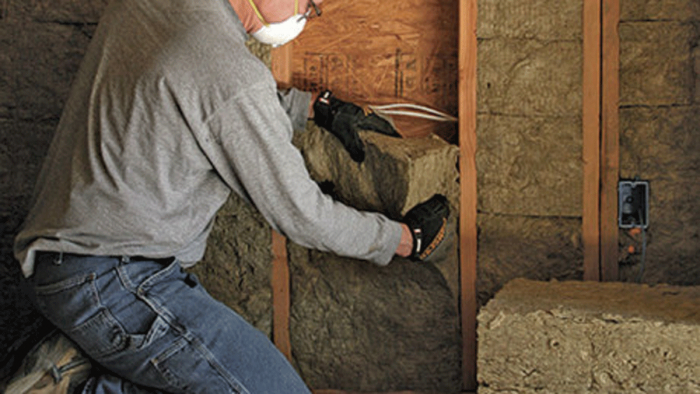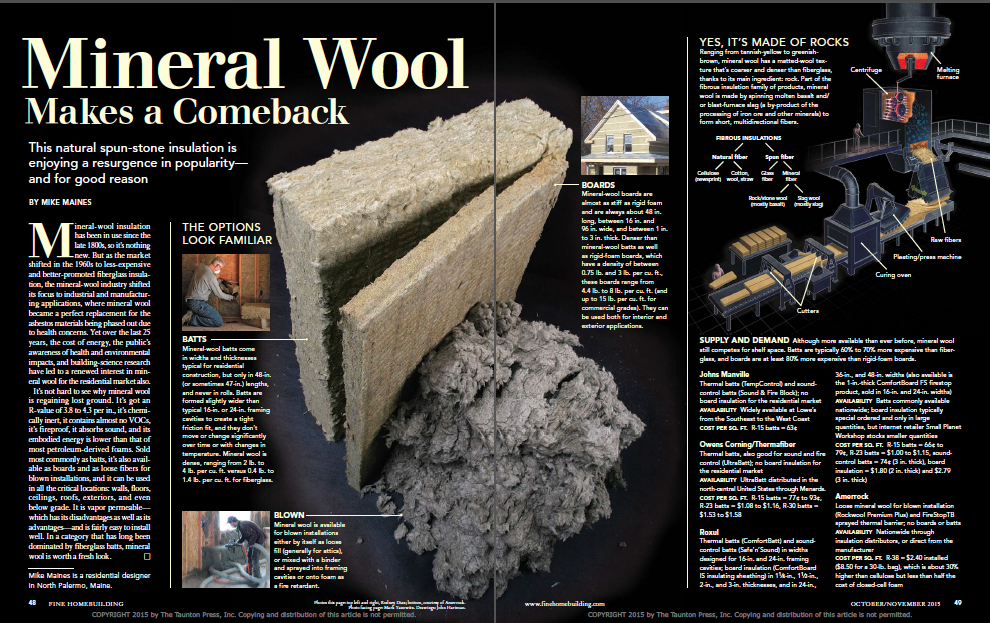Mineral Wool Makes a Comeback
This natural spun-stone insulation is enjoying a resurgence in popularity—and for good reason.

Synopsis: Although it’s long been popular in residential construction in Canada, mineral-wool insulation (also known as rock-wool insulation) has mostly been limited to commercial building in the United States. Thanks to a renewed push from manufacturers and a growing interest from builders, mineral wool is starting to gain traction among builders in the States, particularly because of its inherent fireproof, watershedding, and chemically inert qualities. Residential designer Mike Maines takes a close look the material, from its basic traits to best practices for installation. A chart shows how mineral wool compares to other insulation materials in five categories: R-value, water-vapor permeability, airflow resistance, fire control, and sound control.
Mineral-wool insulation has been in use since the late 1800s, so it’s nothing new. But as the market shifted in the 1960s to less-expensive and better-promoted fiberglass insulation, the mineral-wool industry shifted its focus to industrial and manufacturing applications, where mineral wool became a perfect replacement for the asbestos mate rials being phased out due to health concerns. Yet over the last 25 years, the cost of energy, the public’s awareness of health and environmental impacts, and building-science research have led to a renewed interest in mineral wool for the residential market also.
It’s not hard to see why mineral wool is regaining lost ground. It’s got an R-value of 3.8 to 4.3 per in., it’s chemically inert, it contains almost no VOCs, it’s fireproof, it absorbs sound, and its embodied energy is lower than that of most petroleum-derived foams. Sold most commonly as batts, it’s also available as boards and as loose fibers for blown installations, and it can be used in all the critical locations: walls, floors, ceilings, roofs, exteriors, and even below grade. It is vapor permeable — which has its disadvantages as well as its advantages — and is fairly easy to install well. In a category that has long been dominated by fiberglass batts, mineral wool is worth a fresh look.
Yes, it’s made of rocks
Ranging from tannish-yellow to greenish-brown, mineral wool has a matted-wool texture that’s coarser and denser than fiberglass, thanks to its main ingredient: rock. Part of the fibrous insulation family of products, mineral wool is made by spinning molten basalt and/or blast-furnace slag (a by-product of the processing of iron ore and other minerals) to form short, multidirectional fibers.
Supply and demand
Although more available than ever before, mineral wool still competes for shelf space. Batts are typically 60% to 70% more expensive than fiberglass, and boards are at least 80% more expensive than rigid-foam boards.
Boards
Mineral-wool boards are almost as stiff as rigid foam and are always about 48 in. long, between 16 in. and 96 in. wide, and between 1 in. to 3 in. thick. Denser than mineral-wool batts as well as rigid-foam boards, which have a density of between 0.75 lb. and 3 lb. per cu. ft., these boards range from 4.4 lb. to 8 lb. per cu. ft. (and up to 15 lb. per cu. ft. for commercial grades). They can be used both for interior and exterior applications.
 From Fine Homebuilding #254
From Fine Homebuilding #254
For more photos, illustrations, and details, click the View PDF button below:
Fine Homebuilding Recommended Products
Fine Homebuilding receives a commission for items purchased through links on this site, including Amazon Associates and other affiliate advertising programs.

Respirator Mask

Loctite Foamboard Adhesive

Foam Gun






View Comments
The problem with these types of sites is that they always leave something out about each product.This stuff is bad for your lungs.Everyone knows the nightmare that homeowners have had by using great products that are bad for your air.Also alot of the basement insulation touted offgasses,thats a future pet peave.
user-6087192, we had to chop down roughly 30 pages of writing into a 6-page article with lots of images, so yes, some information does not make the final cut. We addressed your safety concern by saying that respirators are recommended. We also address offgassing: there is very little with mineral wool; some formaldehyde is used by most manufacturers but it is almost entirely baked off at the factory.
Only the loose particles are bad for you lungs. I use a 3M respirator and gloves when installing mineral wool just as I would when installing fiberglass. As far as off gassing most off the insulation materials in use today release off gasses. However nothing fills a cavity better than rock wool; unless you decide to use spray foam.
If you have a large job I’d recommend a cutting table for precise cuts. One can be made from easily sourced materials: plywood, door hinges and two saw horses.
Rock wool batts are not as easy to cut as fiberglass. They have poor "loft" qualities, which means they're a real pain to fit into non-standard cavities. And if you can't properly fill a space, the increased r-value (vis-visit fiberglass) is unrealistic. I personally find most newer fiberglass batts less itch-provoking than once-upon-a-time (I'm 62), but Roxul (the most often used brand in ontario/quebec) every bit as nasty as old-fashioned rock wool.
If an installer doesn't like working with the stuff, he/she is gonna do a poor job
Worked a early-40s attic with 3/4 to 1 inch loose rock wool that was in windrows due to wind and mice. Not sure what they thought they'd accomplished, since the entire rest of the house was totally without insulation or even sealing. Had to wear full tyvek bodysuits with booties, sealed arms to gloves, hood, respirators. That stuff was filthy with dust & contaminants. Homeowner decided it was futile to insulate attic as couldn't afford to upgrade entire house.
I'd consider rock wool sheets for exterior walls. Swore off blowing loose cellulose in attics in favor of fiberglass. Haven't seen an article on blowing rock wool, and it wasn't available in that city, anyway.
After all the article on improper installation of fiberglass batts in walls, doesn't that apply to rock wool batts?